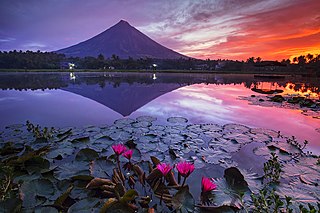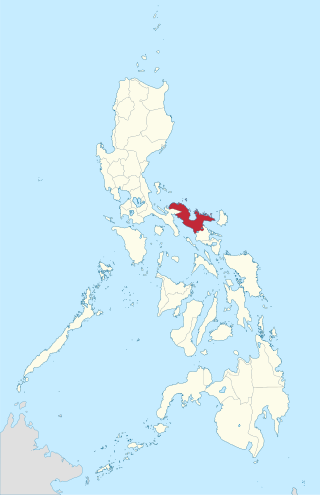
The Philippine Constabulary was a gendarmerie-type military police force of the Philippines from 1901 to 1991, and the predecessor to the Philippine National Police. It was created by the American occupational government to replace the Spanish colonial Guardia Civil, happened on the 19th century history of the Philippines. It was the first of the four branches of the Armed Forces of the Philippines. On January 29, 1991, it was merged with the Integrated National Police to form the Philippine National Police.

Albay, officially the Province of Albay, is a province in the Bicol Region of the Philippines, mostly on the southeastern part of the island of Luzon. Its capital is the city of Legazpi, the regional center of the whole Bicol Region, which is located in the southern foothill of Mayon Volcano.

The Bicol Region, commonly shortened to Bicol and designated as Region V, is an administrative region of the Philippines. Also referred to as Bicolandia, it comprises six provinces, four on the Bicol Peninsula : Albay, Camarines Norte, Camarines Sur, and Sorsogon, and two off the shore: Catanduanes and Masbate.

Camarines Sur, officially the Province of Camarines Sur, is a province in the Philippines located in the Bicol Region on Luzon. Its capital is Pili and the province borders Camarines Norte and Quezon to the northwest, and Albay to the south. To the east lies the island province of Catanduanes across the Maqueda Channel.

Camarines Norte, officially the Province of Camarines Norte, is a province in the Philippines located in the Bicol Region in Luzon. Its capital is Daet. The province borders Quezon to the west, Camarines Sur to the south, and the Philippine Sea to the north. It has historically been a Bikol-speaking region. However, there has been a language shift in recent years to Tagalog, which is more commonly used nowadays.

Guinobatan, officially the Municipality of Guinobatan, is a 1st class municipality in the province of Albay, Philippines. According to the 2020 census, it has a population of 85,786 people.

Polangui, officially the Municipality of Polangui, is a 1st class municipality in the province of Albay, Philippines. According to the 2020 census, it has a population of 89,176 people.

Santo Domingo, officially the Municipality of Santo Domingo,, is a 4th class municipality in the province of Albay, Philippines. According to the 2020 census, it has a population of 37,765 people.

Bombon, officially the Municipality of Bombon, is a 4th class municipality in the province of Camarines Sur, Philippines. According to the 2020 census, it has a population of 17,995 people.

Camaligan, officially the Municipality of Camaligan, is a 4th class municipality in the province of Camarines Sur, Philippines. According to the 2020 census, it has a population of 25,036 people. Camaligan rapidly became an urban town during the 1990s.

Iriga, officially the City of Iriga, is a component city in the province of Camarines Sur, Philippines. According to the 2020 census, it has a population of 114,457 people.

The Metropolitan Archdiocese of Cáceres is a Latin Church archdiocese of the Catholic Church in the Philippines. It is a metropolitan see that comprises the Bicol Region, while directly overseeing the third, fourth, and fifth congressional districts of Camarines Sur, Naga City, Iriga City and the Municipality of Gainza. The archdiocese, having been founded in 1595 in Nueva Cáceres, is also considered one of the oldest dioceses in the Philippines with Cebu, Segovia and Manila, and once had jurisdiction that stretched from Samar in the south and Isabela Province in the north. The seat of the archdiocese is currently located in Naga City, also known as the Queen City of Bicol.

The Bicolano people are the fourth-largest Filipino ethnolinguistic group. Their native region is commonly referred to as Bicolandia, which comprises the entirety of the Bicol Peninsula and neighboring minor islands, all in the southeast portion of Luzon. Males from the region are often referred to as Bicolano, while Bicolana may be used to refer to females.

Ambos Camarines, officially the Province of Ambos Camarines, was a historical province in the Philippines found on the northern end of the Bicol Peninsula. It now exists as two separate provinces: Camarines Norte and Camarines Sur.

Central Bikol, commonly called Bikol Naga or simply as Bikol, is an Austronesian language spoken by the Bicolanos, primarily in the Bicol Region of southern Luzon, Philippines. It is spoken in the northern and western part of Camarines Sur, second congressional district of Camarines Norte, eastern part of Albay, northeastern part of Sorsogon, San Pascual town in Masbate, and southwestern part of Catanduanes. Central Bikol speakers can be found in all provinces of Bicol and it is a majority language in Camarines Sur. The standard sprachraum form is based on the Canaman dialect.

The La Loma Catholic Cemetery was opened in 1884 and is largely located in Caloocan, Metro Manila. A portion of the southern part of the cemetery is located in Manila.
The Philippine Historical Association is a professional association of historians in the Philippines and is considered one of the oldest organizations of historians in the country. It was founded on September 18, 1955 by a group of prominent historians at Carbungco Restaurant located at Lepanto St., Manila. Among the group were Encarnacion Alzona, Gabriel Fabella, Gregorio Zaide, Nicolas Zafra, Celedonio Resurreccion, Teodoro Agoncillo and Esteban de Ocampo.

Del Monte Land Transport Bus Company (DLTBCo) is a provincial bus company formed as a subsidiary of Del Monte Motor Works, Incorporated. It was formed as a resurgent of Batangas Laguna Tayabas Bus Company Incorporated (BLTBCo.), one of the oldest provincial bus companies in the Philippines. It plies routes mainly to Southern Luzon provinces and other parts in Eastern Visayas region.

Jose Ma. Panganiban y Enverga was a Filipino propagandist, linguist, and essayist. He is one of the main writers and contributors for La Solidaridad, writing under the pen names "Jomapa" and "J.M.P."

The Philippine Constabulary Band was the principal military band of the Philippine Constabulary, and later, as the Philippine Army Orchestra, of the Army of the Commonwealth of the Philippines. Between its establishment in 1901 and dissolution during World War II, it registered a reputation for musical excellence both in the Philippines and the United States, and is credited with being the first band other than the United States Marine Band to provide the musical escort to the president of the United States during a U.S. presidential inauguration. The Philippine National Police Band from Camp Crame,considers the successor to the Philippine Constabulary Band. The Philippine Army Band considers itself as a successor too.



















